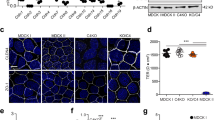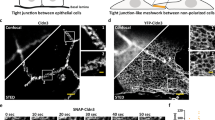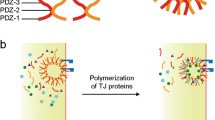Abstract
DURING epithelial morphogenesis, the establishment of tight junctions precedes the development of both the asymmetry in protein and lipid composition between apical and basolateral cell surfaces (the 'fence' function) and the restriction in the transport of ions and nonelectrolytes through the extracellular clefts between cells (the 'gate' function)1,2. Molecular models that explain both functions envision strands of particles extending as rings in the cell's perimeter that interact with similar strands located at the apposing cell2–5. This model accounts for the 'fence' function, because the strands prevent diffusion of protein and lipids, and also for the 'gate' function, because the interaction between strands minimizes the width of the extracellular clefts, increasing transepithelial resistance to ions and decreasing non-electrolyte permeability. Here we describe the results of energy depletion, which for the first time separates both functions: it abolishes the gate function, as determined by the dramatic decrease in transepithelial resistance, but it leaves the fence function intact, as determined by the maintenance of lipid polarity.
This is a preview of subscription content, access via your institution
Access options
Subscribe to this journal
Receive 51 print issues and online access
$199.00 per year
only $3.90 per issue
Buy this article
- Purchase on Springer Link
- Instant access to full article PDF
Prices may be subject to local taxes which are calculated during checkout
Similar content being viewed by others
References
Diamond, J. Physiologist 20, 10–18 (1977).
Gumbiner, B. Am. J. Physiol. 253, C749–C758 (1987).
Claude, P. & Goodenough, D. A. J. Cell Biol. 58, 390–400 (1973).
Claude, P. J. Membr. Biol. 39, 219–232 (1978).
Cereijido, M., Ponce, A. P. & Gonzalez-Mariscal, L. J. membr. Biol. 110, 1–9 (1989).
Dragsten, P. R., Blumenthal, R. & Handler, J. S. Nature 294, 718–722 (1981).
van Meer, G. & Simons, K. EMBO J. 5, 1455–1464 (1986).
Nelson, W. J. & Hammerton, R. W. J. Cell Biol. 108, 893–902 (1989).
Bennett, V. & Lambert, S. J. clin. Invest. 87, 1483–1489 (1991).
Muckter, H. Ben-Shaul, Y. & Bacher, A. Eur. J. Cell Biol. 44, 258–264 (1987).
Nigam, S. K., Denisenko, N., Rodriguez-Boulan, E. & Citi, S. Biochem. biophys. Res. Commun. 181, 548–553 (1991).
Molitoris, B. A., Dahl, R. H. & Falk, S. A., J. clin. Invest. 84, 1334–1339 (1989).
Stevenson, B. R., Anderson, J. M. & Bullivant, S. Molec. cell. Biochem. 83, 129–145 (1988).
Stevenson, B. R., Anderson, J. M., Goodenough, D. A. & Mooseker, M. S. J. Cell Biol. 107, 2401–2408 (1988).
Ladino, C., Schneeberger, E. E., Rabito, C. A. & Lynch, R. D. Eur. J. Cell Biol. 55, 217–224 (1991).
Madara, J. L. & Dharmsathaphorn, K. J. Cell Biol. 101, 2124–2133 (1985).
Ojakian, G. Cell 23, 95–103 (1981).
Mullin, J. E. & O'Brien, T. G. Am. J. Physiol. 251, C597–C602 (1986).
Madara, J. L. J. clin. Invest. 83, 1089–1094 (1989).
Mandel, L. J., Takano, T., Soltoff, S. P. & Murdaugh, S. J. clin. Invest. 81, 1255–1264 (1988).
Bacallao, R., Bomsel, M., Stelzer, E. H. K. & De Mey, J. in Handbook of Biological Confocal Microscopy (ed. Pawley, J. B.) 197–205 (Plenum, New York, 1990).
Zampighi, G., Kreman, M., Ramon, F., Moreno, A. L. & Simon, S. A. J. Cell Biol. 106, 1667–1678 (1988).
Pagano, R. E. & Martin, O. C. Biochemistry 27, 4439–4445 (1988).
Author information
Authors and Affiliations
Rights and permissions
About this article
Cite this article
Mandel, L., Bacallao, R. & Zampighi, G. Uncoupling of the molecular 'fence' and paracellular 'gate' functions in epithelial tight junctions. Nature 361, 552–555 (1993). https://doi.org/10.1038/361552a0
Received:
Accepted:
Issue Date:
DOI: https://doi.org/10.1038/361552a0
This article is cited by
-
The mechanobiology of tight junctions
Biophysical Reviews (2019)
-
Tight junctions: from simple barriers to multifunctional molecular gates
Nature Reviews Molecular Cell Biology (2016)
-
Effects of calcium oxalate monohydrate crystals on expression and function of tight junction of renal tubular epithelial cells
Laboratory Investigation (2011)
-
Air–liquid interface cultures enhance the oxygen supply and trigger the structural and functional differentiation of intestinal porcine epithelial cells (IPEC)
Histochemistry and Cell Biology (2011)
-
Brain endothelial cells and the glio-vascular complex
Cell and Tissue Research (2009)
Comments
By submitting a comment you agree to abide by our Terms and Community Guidelines. If you find something abusive or that does not comply with our terms or guidelines please flag it as inappropriate.



